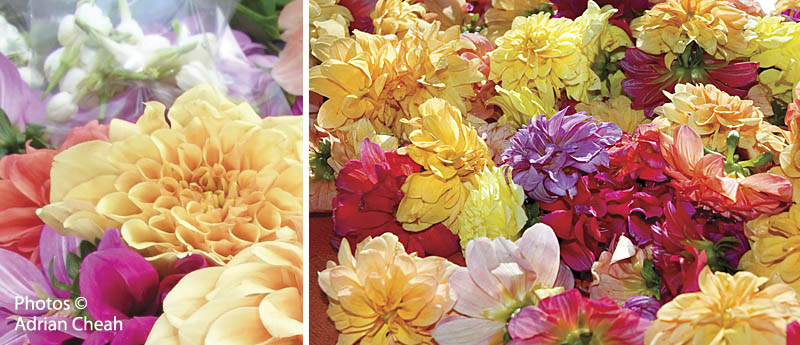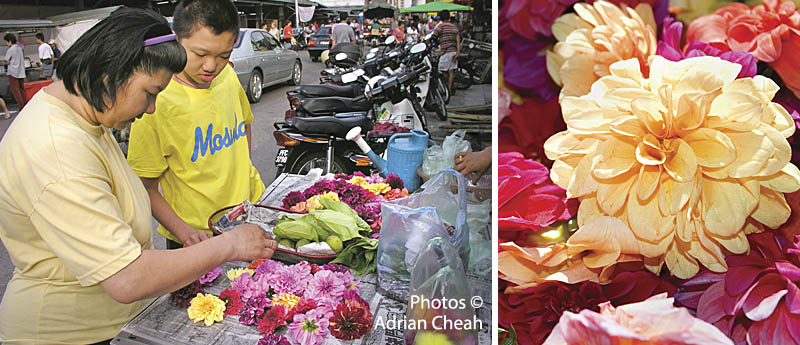The floral bath (mandi bunga) ritual

The Russian musician Igor Stravinsky might have composed Le Sacre du Printemps (The Rites of Spring) as an exploration of nature and the rituals of renewal and sacrifice, but one could safely conjecture that the ritual and ceremony of the Malaysian floral bath was created for more personal (and less lofty) reasons. The two may be worlds apart, but both Stravinsky and the local bomoh share one thing – invoking the power and the mystery of nature and the elements in their work.

Floral baths are found in different cultures of Malaysia – Malay, Chinese, Indian. The whys and wherefores of partaking in such rites are various. For example, a girl hoping to seek a life partner may resort to a session of mandi bunga, whilst another who has been plagued with misfortune hopes to expel bad mojo (or in local parlance, to "buang suey"). As a child, I recalled my mother taking floral baths and vigorously rubbing pomelo leaves between the palm of her hands before a game of mahjong!
How effective are such baths in achieving desired results? Does it really work, or could it be nothing more than a case of mind over matter? Could human beings be able to exert a tangible influence upon real life – simply through the power of conscious intention, unconscious intention, or through the assistance of spiritual beings?

Teaching them young – a mother chooses the seven types of flowers for her floral bath at the Ayer Itam market while her son looks on with interest.
Whatever may result from taking a floral bath, its process and practice is deeply ingrained in the local psyche. It is a tradition and a habit that has been observed for many generations. Malaysians, regardless of age, are more likely to believe in the power of mandi bunga than to dismiss it outright. In any case, if all else fails, a mandi bunga episode would at least leave the person smelling sweet and looking fresh!
A girl seeking a partner in marriage partakes in a floral bathing ceremony in the hope of catching a good and desirable husband. A bomoh (Malay medicine man or shaman) usually oversees such a ceremony. He begins by asking the maiden to carefully prepare the required ingredients that will be mixed with the bathwater. These ingredients are usually plant-based and include different types of fragrant flowers, coconut leaves, betel leaves, betel nuts, limau purut (Citrus hystrix) and akar sintok (Cinnamomum sintok BI.). They are to be used together with other materials which include ibu lilin (wax), benang mentah (unprocessed thread), chalk and bedak sejuk (face powder made from rice grains).
The ceremony begins with the bomoh weaving four strands of coconut leaves into a shape. Then the wax is melted with the thread used as a wick. When that has been prepared and put aside, eight pieces of limau purut (cut from four fruits), some limau purut leaves, seven types of flowers, akar sintok, four betel leaves rubbed with a little chalk, and some ripe betel are kneaded thoroughly and placed in a special vessel filled with water. The bomoh then recites an incantation over the prepared ingredients while sprinkling grains of uncooked glutinous rice around the maiden.
After the incantation has been recited, the bomoh bathes the girl with the prepared liquid. (It should be mentioned here that the maiden is usually dressed in a sarong while the bathwater is poured over her, and the entire ceremony is conducted with a selected audience).
Of course, not all floral baths are used to ensnare husbands. Some purposes are more 'prosaic'. For example, one may indulge in a floral bath for no other reason than to refresh the mind and body, and to beautify the skin. Floral baths that use plants as the main ingredients are also believed to shield people from calamities and disasters as well as to exorcise bad fortune. Baths can be conducted by bomohs (for magical purposes), beauty salons (for cosmetic benefits), or self-administered. Suffice it to say that the ritual of Mandi Bunga is good for all occasions.
---------------------------------------------------------
Written by Raja Abdul Razak
Photographed by Adrian Cheah © All rights reserved
Updated 30 April 2019